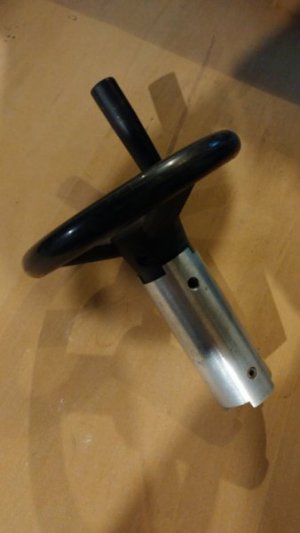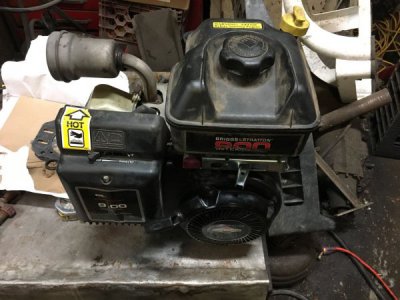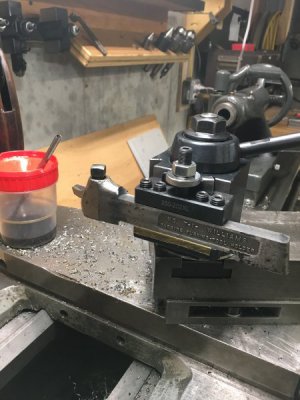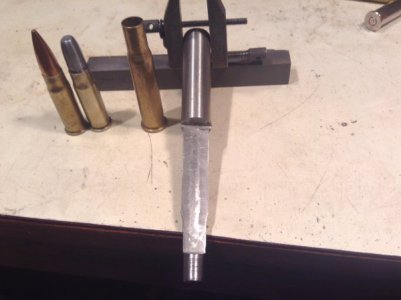Not exactly in the shop, but a project nonetheless.
About 2 weeks ago the dogs started tracking mud into the kitchen from outside.

But I hasn't rained here in about a month, there is no standing water anywhere. They like to dig a hole and lay in it when it gets hot so I just assumed it was coming from that, but I couldn't find any mud, just some dry dirt. Well it turns out I was wrong. I followed one of them out by the the fence and found the mud.
It turns out that the well water line was leaking at the wellhead, about a gallon a minute.

Wasn't enough to really cause a water pressure drop so didn't affect anything in the house so I didn't know I had a problem. So grab a shovel and start digging around the well casing, I can see where the water is coming up at so dig in that area.....Until I hit a big tree root.
Then the fun begins. Ok, dig around the root, carefully, so not to hit the electrical cable or actually break the pipe. Finally was able to get air under both ends of the root and no pipe or cable in the way, so grab the chain saw and cut the root at both ends, about 4 inch diameter. It was pretty much welded to the pipe, had to make another cut to get it loose. Also pretty much destroyed the saw chain, they don't like mud.
All this time the water is still leaking into the hole, but I was able to dig a channel to keep the work area dewatered. I didn't turn the well pump off because I didn't want groundwater leaking into the well so I was keeping the system pressurized.
Ok getting closer to the leak, so dig a bit more and.......Hit another big root. So start digging around that root and now I'm deep enough that my drainage channel is no longer working and I'm below the lawn grade so I can't go down any more. So off to the rental shop and rent a trash pump. Dug a sump for the pump pickup and keep digging.
This time I found the electrical cable and the water pipe, kind of under the root. Clean out under the root and grab the chainsaw again, got that root out by cutting it into 3 pieces. So now I have about a foot of the water pipe exposed and know exactly where the power wire runs. But......
The water pipe connection to the Pitless Adapter is back under another even larger root, about an 8 inch or so. By this time I'm into this about 1 1/2 days. Now it was time to turn off the pump, cut and cap the water pipe on both sides of the cut to keep the mud out. So dig out around the pipe and remove a couple of small finger roots that were intertwined with the power cable. So after more digging to get some working room I was able to cut and cap the water pipe.
Now time to attack the big root, and the one that started the whole problem. Tried getting through it with the chainsaw but the chain was so dull by now it was useless. So grab the Sawzall and start removing pieces of root. About 2 hours later, I can finally get to the broken fitting.
I didn't get any pictures of the process, but I did take a few after the repairs were made.
The view from outside of the work area.
View attachment 272393
That's a lot of dirt, you get down about 8 inches and it's gooey clay, nasty stuff to dig in. A few pieces of root laying around
View attachment 272394
And the repair, a piece of schedule 80 screwed into the Pitless Adapter, and schedule 40 for the rest. It's about 3 feet down to the pipe. The other piece of pipe that is capped off was abandoned when the pump was replaced in 1989, I have no idea where it goes. The root system all grew in the last 29 years. I may dig out that big root laying on top of the pipe, it's not connected to the tree any longer.
View attachment 272395
For those of you who do not know what a Pitless Adapter is
View attachment 272398
The white blob just to the left of the well casing was the big root that actually broke the fitting.
View attachment 272397
That tree was probably a lot smaller 29 years ago. I have no idea when the well was dug, but I'm guessing that tree was about Christmas tree size when the well was installed, it's about 100 feet tall now, and maybe it was planted after the well was in. Not the best place for a tree that will develop a large root system. The good news is that there are a lot more big roots holding the tree up, so even with what I took out I'm pretty sure it won't fall over in the next wind storm.
 View attachment 272396
View attachment 272396
I suspect this has been leaking for a year or more and just getting worse over time. It just finally surfaced in the last couple of weeks. I'll be filling in the hole with pea gravel, not going to fight that clay again if I ever have to go back into that hole. I'm getting too old for this, that was a lot of work.

 Or at least renting one.
Or at least renting one.






